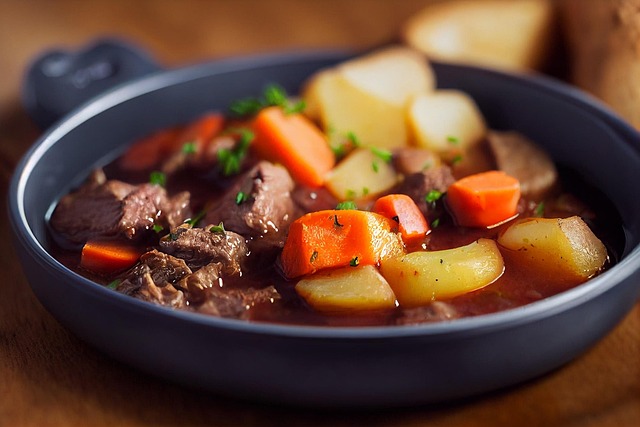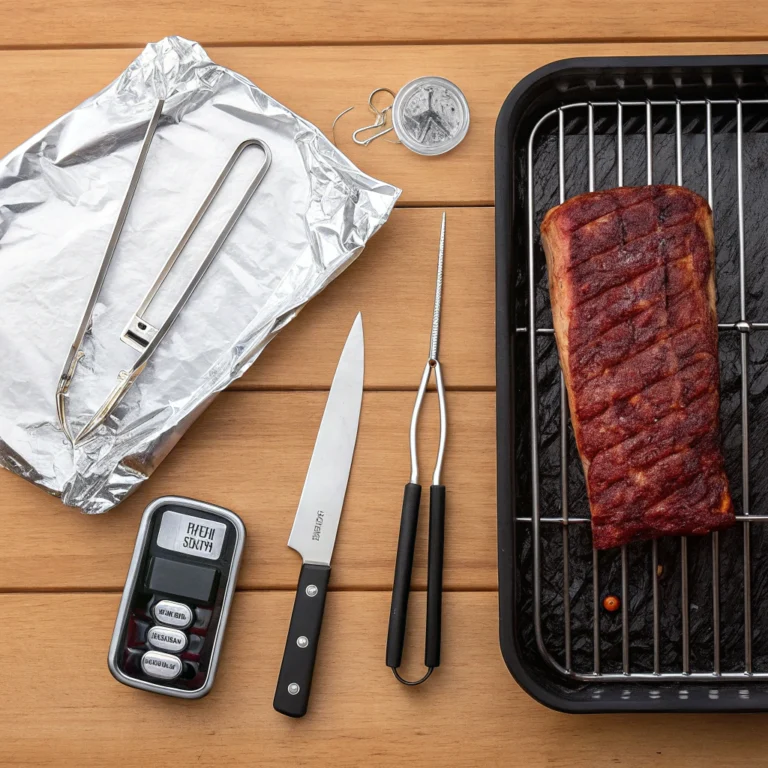Easy Beef Stew Recipe: Hearty & Delicious Dinner in Just One Pot
- Key Takeaways
- The soul of a simple stew
- My easy beef stew recipe
- Beyond the recipe: my secrets
- How to adapt your stew
- Why your stew isn’t perfect
- What to serve with it
- Conclusion
- Frequently Asked Questions
Key Takeaways
- Flavorful beef stew starts with quality ingredients. Choose tender cuts such as chuck roast and incorporate fresh vegetables for flavor and consistency.
- Proper preparation, including even cutting and seasoning, guarantees that everything cooks evenly and gets as much flavor as possible.
- Browning the beef and sweating the vegetables develops a deep flavor base for the stew. These steps really add layers of flavor to the end product.
- Selecting the appropriate liquids, such as beef broth or red wine, impacts the stew’s flavor and texture. Add or subtract liquids to obtain desired consistency.
- Try flavor layering & deglazing for an easy stew that will wow your family and friends. Adding spices later, scraping up browned bits – can all make a difference in overall flavor.
- Make the recipe your own by adjusting the ingredients or experimenting with cooking techniques. Adaptability makes it fun and forgiving.
Nothing like an easy beef stew recipe to really hit that comfort food craving with gusto. By mixing classic ingredients such as beef, vegetables, and broth – you can make a delicious meal that warms the body and soul.
It’s great for hectic weeknights or lazy weekends, providing a delicious family dinner solution. So, in this post you’ll discover some step-by-step instructions and tips to make your beef stew delicious and a crowd-pleaser.
The soul of a simple stew
A simple stew can become a soul-warming feast on cold nights. For its capacity to unite flavors and unite people, it’s more than sustenance, it’s comfort.
The beef
Selecting the appropriate cut of beef is important for achieving tenderness, with options such as chuck roast or beef shin being great choices. They just sort of fall apart while cooking, making sure to be oh so flavorful.
Slice the beef into equal pieces to ensure even cooking. This is crucial, because if they’re uneven then some will be overcooked while others stay chewy. Be sure to season the beef well prior to cooking. Salt and pepper are your foundational friends, but try some garlic powder or smoked paprika for a bit of teeth.
Browning the beef before adding it to the stew is a trick worth learning. This step can add an umami, sumptuous element that takes the dish to the next level.
The vegetables
Simple ingredients like fresh carrots, onions, and celery offer vital flavor and crunch. Their inherent sweetness offsets the saltiness of the beef beautifully.
Chop the vegetables into uniform sizes for even cooking — and consistent flavor in every bite. You can throw in some potatoes or peas for extra heartiness. Seasonal veggies add freshness, so think local to you.
The liquid
Use beef broth or stock as a base; it gives the most incredible flavor. Red wine adds magic, but if you don’t, make it non-alcoholic with grape juice.
Adjust the amount of liquid to taste for the thickness of your stew. A too-thin stew is without body, but a too-thick one can be heavy. The addition of tomato paste really saturates the broth, giving it a nice color and depth of flavor.
The aromatics
Fresh thyme and rosemary add a beautiful aroma. Sautéed garlic and onions provide the earthy base, with bay leaves offering nuance.
Modify the herb mixture to accommodate your own taste, and this is where you can personalize the recipe.
My easy beef stew recipe
My gosh, this easy beef stew recipe takes all the hassle out of THE classic winter stew recipe. Here’s how to turn mine into nothing short of comfort food you can savor anytime.
1. Prepare
First, dry and season the beef cubes in a large bowl. Sprinkle with flour, salt and pepper, and toss well to coat evenly. This step promotes browning during cooking, which leads to a richer flavor.
Dice up some saute vegetables – carrots, onions, celery, etc., in advance to save you time prepping. Pre-measure liquids and spices to keep your cooking organized. Make a clean work area.
2. Sear
Before you throw the beef in, heat some oil in your dutch oven. That guarantees a nice sear, which seals in flavor. Brown the beef in batches, otherwise it will steam. Seek a deep brown color, this shows caramelization has occurred.
Let the meat rest briefly afterward for maximum juiciness.
3. Sauté
After browning the beef, sauté your aromatics. Sauté onions, carrots and celery to golden to bring out the flavor. Add garlic and herbs, and stir to release their essential oils.
Keep a close eye on the heat to avoid burning. Stir in the sautéed vegetables with the beef to combine.
4. Simmer
I add the liquids slowly, to keep the stew from being too thin. Allow to come to a gentle simmer and cover. Let it cook for a nice, long while, checking periodically and stirring to keep it from sticking.
Beyond the recipe: my secrets

Learn how to transform the simple beef stew into a gourmet experience. These secrets will up your cooking game and create a flavor-packed dish that’s both decadent and unforgettable.
Flavor layering
Layering flavors, or adding ingredients at different points in the cooking process, is essential. Begin with fragrant veggies such as onions and carrots, then slowly add spices and herbs. This technique intensifies the flavor and lets each component stand out.
Taste as it cooks and season accordingly. For example, a mix of thyme, rosemary, and bay leaves can impart an aromatic flair that distinguishes your stew.
Try mixing up the herb blends to what suits your ingredients. A pinch of smoked paprika can add surprise warmth, and fresh parsley can enliven the dish at the end.
Deglazing power
Deglazing is a (very!) powerful technique that snags all those yummy bits glued to the pot bottom after you’ve browned the meat.
Deglaze with wine or broth, pouring it in and scraping up those tasty bits! This step adds sauce and flavor. To intensify these flavors, reduce the liquid a bit—making a deliciously rich foundation for your stew.
Low and slow
Going for longer times lets the tough cuts of meat break down beautifully. A low heat setting promotes gentle cooking and flavor building, which will make your stew tender and full of depth.
Slow cooker? Set it and forget it! Once cooked, let the stew rest at least 15 minutes, allowing the flavors to marry beautifully.
The final stir
Stir before serving. Taste again—a little extra salt or dash of vinegar really makes a difference.
Enjoy promptly for optimal crunchiness and heat, or allow it to rest to cool off just a bit before serving.
How to adapt your stew

Here are a few good ways to adapt your stew.
Cooking methods
- Stovetop cooking for a quick and traditional approach
- Slow cooker for set-it-and-forget-it convenience
- Pressure cooking for a faster alternative
- Adapt cooking times based on the method chosen
Stovetop is great if you’re in a hurry. So you can make adjustments and monitor flavors as you go along. If you’re on the go, the slow cooker is your best friend — just set it in the a.m. Come home to stew perfection.
For a speed boost, pressure cooking cuts the cook time in half, preserves tenderness, and enhances flavor. Each way takes a different amount of cooking time, so be sure to adapt your stew!
Dietary needs
- Gluten-free options (e.g., using cornstarch instead of flour)
- Dairy-free alternatives (e.g., coconut milk instead of cream)
- Low-sodium broth for hypertension
- Vegetarian substitutes, such as lentils or mushrooms
For those with dietary restrictions, think about gluten-free thickeners such as cornstarch. You can use coconut milk to replace dairy for a creamy, lactose-free alternative.
Modify your vegetable selections for allergies or preferences and still serve up a crowd-pleaser. Remember to read seasonings, some are loaded with gluten or sodium.
Flavor twists
Incorporating unique ingredients can elevate your stew. Adding mushrooms, for instance, enhances umami flavor, while fresh herbs like thyme or rosemary can brighten the dish.
Spices such as paprika or cumin introduce warmth and complexity. You can experiment with different liquids. Using beer or cider can provide depth and richness.
Lastly, seasonal produce not only keeps the dish fresh but adds a vibrant touch.
Why your stew isn’t perfect

Creating a beef stew ought to be a warm, fuzzy thing. There are a few tried and true problems that will stop your stew from being perfect. Below we’ll dive into these traps, their origins, and pragmatic fixes.
Common Issues | Causes | Suggested Solutions |
|---|---|---|
Tough meat | Wrong cut or insufficient cooking time | Use appropriate cuts, cook long enough, avoid high heat, and consider marinating. |
Thin broth | Insufficient liquid or thickening agent | Adjust liquid amounts, use thickeners, simmer uncovered, and taste for seasoning. |
Bland flavor | Lack of seasoning or depth | Build flavor gradually, add umami ingredients, use fresh herbs, and taste frequently. |
Mushy vegetables | Overcooking or wrong cutting size | Monitor cooking times, cut larger pieces, and add frozen veggies later. |
Tough meat
Using the right cut of beef is key. Chop cuts — chuck, brisket — are best, as more collagen breaks down through slow cooking.
Dissolving this collagen requires cooking for a long enough time – generally at least 2 to 3 hours – resulting in melt-in-your-mouth tender meat.
High heat can toughen the meat, so keep it low and steady. To tenderize it further, marinate the beef in a combination of acidic ingredients such as vinegar or citrus juice before cooking.
Thin broth
If your broth is too thin, add more liquid. Adding a thickener, such as cornstarch or flour, can help.
Letting the stew simmer uncovered reduces the liquid and intensifies the flavor. Tasting and adjusting seasoning is key—sometimes a pinch of salt or seasoning can really make the broth come alive with richness.
Bland flavor
Don’t be boring, turn up the seasoning slowly. Umami boosters like worcestershire or soy sauce can intensify flavor profiles.
Fresh herbs, like thyme or rosemary, make it sing. Be sure to taste often and season accordingly — this helps flavors build as your stew cooks.
Mushy vegetables
Avoid mushy vegetables by keeping an eye on cooking times. Cutting vegetables into larger chunks helps them hold their texture.
Tossing in frozen veggies like spinach or broccoli towards the end of cooking can keep them from turning mushy.
What to serve with it

Think about what to serve with it.
Beef stew with crusty bread. The strong character of the stew is a perfect match for the bread. A nice sourdough or baguette for dipping in the rich broth. This pairing doesn’t just elevate the stew, it adds a comforting element that makes the meal feel whole.
Serve with sides like mashed potatoes or rice to soak up the stew’s juices. Creamy mashed potatoes are a great choice, because they give a smooth counterpoint to the chunkiness of the stew. Or, of course, you could always let fluffy rice be the blank slate against which the flavors of the beef and vegetables can pop.
These sides make sure no tasty sauce goes to waste — every bite is a joy!
Add veggie sides like sautéed greens for balance. Greens, such as spinach, kale or Swiss chard, will add a pop of colour to your plate. Their bitterness helps to counterbalance the richness of the stew.
Just sauté the greens with olive oil and garlic for a speedy but delicious side.
Serve a light salad for freshness with the robust stew. A cool salad of mixed greens, cucumbers and a light vinaigrette dressing will offer a refreshing counterpoint to the stew’s warmth. The crispness of fresh vegetables will complement the crunch factor of the meal and add some nutrition.
Conclusion
Well, here’s a beef stew to prove it. There’s nothing like a warm, comforting dish to bring friends and families together. Utilize fresh ingredients and season to taste. Don’t forget, making the recipe your own can breathe life into this classic. Don’t be afraid to play around with different veggies or spices. If your stew hasn’t turned out right, go through the steps and tweak your cooking. Spread your stew around and smile back at you. So, are you ready to craft your own masterpiece? Get your ingredients together and cook on! A delicious beef stew for you to nourish and please.
Frequently Asked Questions
What type of beef is best for stew?
Chuck beef is perfect for stew. It’s something that gets tender and flavorful when cooked slowly. Stay away from lean cuts, they can dry out!
How long should I cook beef stew?
Simmer beef stew for a minimum of 2-3 hours on low heat. This lets the flavors meld and the meat tenderize.
Can I make beef stew in a slow cooker?
Yes, a slow cooker is perfect for beef stew. Cook on low for 6-8 hours or on high for 3-4 hours.
How can I thicken my beef stew?
If you want to thicken your stew, incorporate a slurry of cornstarch and water or some flour. Allow it to simmer until you achieve your desired thickness.
Can I freeze beef stew?
Beef stew freezes great. Let it cool and then pack in airtight containers. Can be frozen for up to 3 months.
What vegetables can I add to beef stew?
Typical vegetables are carrots, potatoes and onions. Feel free to throw in some peas, celery, or mushrooms as well.
How do I store leftover beef stew?
Keep any leftover beef stew in the fridge for up to 3 days. For extended storage, freeze in airtight containers. Warm through and serve.







